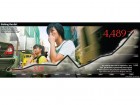I mentioned earlier the report that I delivered to the Beijing Mayor, report that was widely circulated in the Government. At first I thought none of the remarks were taken into account.
Well, maybe they did listen to people like me.
One of my main recommendations was to improve driving manners. See here the article of China Daily, and below the mentioned “bad habits”. Sounds familiar?
Driving manners target of five-year policy, 21 Feb 11, by Chen Xin (China Daily)
As others already pointed out, the new policies should not give us too much hope as enforcement will again be the weakest point. Who will fine bikes who fail to stop for the red light? What is being done about all the cars without a license plate?
Other new positive measures intend to improve parking lots in buildings and related. Too many parkings in buildings are either difficult to use or have simply been converted for other use (like a KTV…).
10 bad habits on the road:
1. forcibly overtaking another vehicle;
2. dangerously weaving between cars;
3. not giving way to pedestrians on a crosswalk;
4. using a cell phone when driving;
5. not wearing a seat belt while driving;
6. freely using the horn;
7. throwing garbage out of car windows;
8. not moving to the curb following a minor traffic accident;
9. running a red light on a bicycle or tricycle;
10. not using a crosswalk or following signals when crossing roads as a pedestrian.
They better hurry up and do something. In the past days we had again AQI levels between 400 and 500. Fortunately today the pollution was blown away and right now we can enjoy a real “blue sky day”.
Year: 2011
Black and white wins by far
The IHT on 7 February 2011 published an article “E-book devices draw in a younger generation”. It also showed a picture of a young reader, shot by Joyce Dopkeen.

While the article was interesting in itself (thinking about my books that do not progress) I was touched by the black & white picture. It has something soft, sensual, retro and poetic that is hard to describe. Would merit a special prize. I went to see the picture online, only to find a reduced quality color pic. Was disappointing, the appeal was not there anymore.
The pic you see here is a scanned version of the hard copy.
Sometimes I feel nostalgic about the old B&W picture we took with our film rolls.
Very high air pollution in Hong Kong
According to Bloomberg on 4 Feb 2011, the Hong Kong API was recently “very high” at two of the roadside monitoring stations: 141 in the Causeway Bay District (where I lived before) and 107 in Central (one of my favorite spots). Now, could those sissies stop complaining? Right on Sunday 13 Feb, despite the snow, Beijing’s AQI had passed 180; then a good wind blew it all away and pollution dropped well below AQI 50.
Well at least in Hong Kong they talk about it. Here, all is well obviously. Thanks to different definitions of what “Very High” means.
We just need to wait till our Beijing drivers transform the city into a parking lot (this week?) and we can look for higher AQI. After short periods of under 50, we should be back in the familiar territory of 150 to 200.
2011 Spring Festival Ball – Beijing Information Office
On 17 January, thanks to Charles Dukes of “Beijing This Month” we were invited to their event at the Beijing Marriott Hotel City Wall. We were happy to have skipped other invitations for the same evening as once again BTM did a great job in organizing a flashy evening.
The evening was presided by Ms. Wang Hui, well known through her role as spokeswoman during the Beijing 2008 Olympics.
If you want to see some beautiful Chinese models – boys and girls, the latest Chinese fashion creations from Zeng Fengfei (designer and general manager of Xiamen Fengfei Costume Design Company), as well as the well-known fashion house Botao, sit back, relax and watch the picture gallery or click [Show picture list]. There are some impressive, elegant and tempting models. Makes us forget the pollution.
Also pictured are the ballroom dancers Liu Lei and Zhao Jing (I think they received the second prize in the national competition). Also the singer Ke Sen from the Bahamas and a group of international enthusiastic dancers.
Not to forget the obvious Chinese Opera group…
The evening ended with some dancing, Sun was invited by one of the dancers for a waltz and more; we could not resist to dance our Brazilian favorite swinging. Thanks Charles for the pics.
The deadly threat from our bad air
In Beijing we are all supposed to be happy with the great efforts of our beloved leaders to achieve so many blue sky days.
Unfortunately, it’s all a lie and for the past 12 months we live with average AQI values of 150 (i.e. the readings of PM2.5 thanks to the USA Embassy). We all know the Embassy is right and representative of the whole Beijing city area. (the normal limit would be AQI=50)
Even official sources in China are starting to question the validity of the official figures, as reported in China Daily.
Well, in Hong Kong they are in great panick because API figures are going over 100. Lucky people! Can we have your air pleeeeeaaaase?
According to recent studies by the University of Hong Kong and other institutes, air pollution causes about 10,000 deaths per year in the Pearl River Delta including Hong Kong and Macao.
The South China Morning Post reported details on 20 January (see here abbreviated version). Their values: they measure as in Beijing, i.e. micrograms of PM10 per cubic meter.
See here a typical reading from the USA Embassy in Beijing:
21 Jan 2011; 12:15; Past 24hr: PM2.5 avg; 52.9 micrograms; AQI=130; Unhealthy for Sensitive Groups
HKU links pollution to increased mortality risks (by SCMP – Elaine Yau)
(pictures are all from SCMP)
For every kilometre of reduced visibility, an additional 70 deaths occurred every year over a decade, a University of Hong Kong survey has found.
Chief researcher Professor Anthony Hedley said visibility was strongly negatively correlated with air pollution, especially with particulates and nitrogen dioxide.
“Loss of visibility kills people,” he said. “The higher the pollutant concentrations, the lower the visibility. Every kilometre in reduced visibility increases our mortality risks.”
The team, which analysed 360,000 deaths between 1996 and 2006 along with data from the Observatory, took into account factors including humidity, temperature and the incidence of flu epidemics.
Postdoctoral fellow in community medicine Professor Lai Hak-kan said that the average visibility in the city over the past four years was 12.6 kilometres, well below the norm of 30 kilometres from a 50-metre structure.
The university’s associate professor in community medicine, Dr Wong Chit-ming, said the situation was alarming. “The visibility in the city was five kilometres yesterday, with 84 micrograms of particulates every cubic metre,” he said.
The World Heath Organisation sets the minimum safety levels at 20 micrograms every cubic metre.
But Hong Kong set the level at 55 micrograms.
Rob Chipman, the chairman of the American Chamber of Commerce in Hong Kong, said last week that pollution was becoming one of the most serious threats to the city’s competitiveness.
The findings of the survey were published in the academic journal Environmental Research.





















